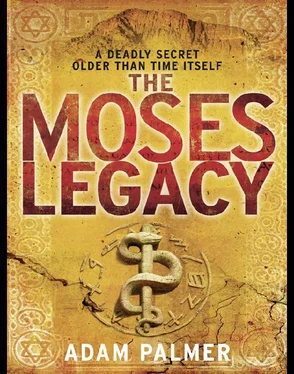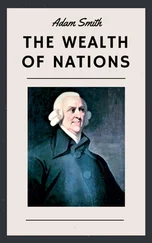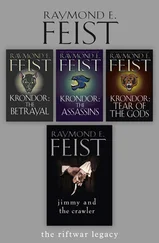Adam Palmer - The Moses Legacy
Здесь есть возможность читать онлайн «Adam Palmer - The Moses Legacy» — ознакомительный отрывок электронной книги совершенно бесплатно, а после прочтения отрывка купить полную версию. В некоторых случаях можно слушать аудио, скачать через торрент в формате fb2 и присутствует краткое содержание. Жанр: Триллер, на английском языке. Описание произведения, (предисловие) а так же отзывы посетителей доступны на портале библиотеки ЛибКат.
- Название:The Moses Legacy
- Автор:
- Жанр:
- Год:неизвестен
- ISBN:нет данных
- Рейтинг книги:4 / 5. Голосов: 1
-
Избранное:Добавить в избранное
- Отзывы:
-
Ваша оценка:
- 80
- 1
- 2
- 3
- 4
- 5
The Moses Legacy: краткое содержание, описание и аннотация
Предлагаем к чтению аннотацию, описание, краткое содержание или предисловие (зависит от того, что написал сам автор книги «The Moses Legacy»). Если вы не нашли необходимую информацию о книге — напишите в комментариях, мы постараемся отыскать её.
The Moses Legacy — читать онлайн ознакомительный отрывок
Ниже представлен текст книги, разбитый по страницам. Система сохранения места последней прочитанной страницы, позволяет с удобством читать онлайн бесплатно книгу «The Moses Legacy», без необходимости каждый раз заново искать на чём Вы остановились. Поставьте закладку, и сможете в любой момент перейти на страницу, на которой закончили чтение.
Интервал:
Закладка:
‘I didn’t know you could read them,’ said Mansoor.
‘I can’t. But I can tell from the way the figures are facing.’
Mansoor nodded approvingly. Hieroglyphic animals and human forms always face the beginning of the line.
‘And do you attribute any significance to that fact?’ asked Mansoor.
‘Only that Semitic languages are written right to left. And I understand that this monument contains the first known reference to Israel.’
‘That is true.’
‘I assume that this has something to do with the reason you’re showing it to me.’
‘Oh yes,’ said Mansoor. ‘When this stone was found, Flinders Petrie called in a German linguist and philologist by the name of Wilhelm Spiegelberg to translate it. As Spiegelberg was nearing the end of his translation, he became confused by something he read. In just two lines close to the end, the inscription switches from Mernepteh’s military victories against Libya, in the west, to his purported triumphs in the east. The text goes something like this: ‘Canaan is captured in misery. Ashkelon is defeated, Gezer is taken, Yanoam is destroyed; Israel is laid waste, nought of seed.’
‘Nought of seed?’ Daniel echoed.
‘It’s a standard formula in the context of ancient war,’ Mansoor explained. ‘You destroy the enemy’s grain supply to weaken them economically.’
‘And it actually says “Israel”?’ asked Daniel.
‘The word that Spiegelberg read out phonetically was actually Isrir.’
‘But there’s a problem with that timeframe, isn’t there?’ said Daniel. ‘I mean, the stone dates from 1208 or 1209 BC. And according to the archaeological record, Israelite settlement in Canaan didn’t begin until shortly after that.’
‘Yes, but nowhere on this stone does it say that Isrir was in Canaan.’
‘No, but hold on a minute. All those other places were: Ashkelon, Gezer, Yanoam. And Isrir is mentioned right after them, implying that it was in the same general location.’
‘Ah, now it’s interesting that you mention that,’ Mansoor replied, obviously in his element. ‘Because the text actually distinguishes between those other places and Isrir. Ashkelon, Gezer and Yanoam are all followed by a throwstick symbol and three mountains. Those symbols represent a city state. In other words, each of those places was a city state. But the name Isrir, on the other hand, is followed by a throwstick followed by the figures of a man and a woman. And those symbols represent a foreign people rather than a city state. So, in effect, the text is telling us that Isrir was a people without a country.’
‘But what about the fact that it says they were destroyed?’ asked Daniel. ‘Evidently the Israelites weren’t destroyed because they were still around later.’
‘No, but you have to understand that mighty though the ancient Egyptians were, they were not averse to a touch of hyberbole. They were politicians after all.’
‘You said that a papyrus was found at the same site as this.’
‘Yes. It’s in the archives.’
Mansoor led them once again to the basement archives and showed Daniel and Gabrielle a papyrus fragment containing ancient script. Daniel sat down and stared at it for a long time, referring to his concordance to check each word.
‘Can you translate it?’ Mansoor asked encouragingly.
Daniel peered at the papyrus again before struggling with the words out loud. ‘He killed the women who drew forth the sons, but spared them the daughters.’
‘That doesn’t make sense,’ said Gabrielle.
‘No, of course not,’ said Mansoor. ‘The women who drew forth the sons – presumably that means the midwives. But they would have had the same midwives for sons and daughters.’
‘Wait a minute, I think I can solve it. They’re using the causative case. It’s not “He killed,” it’s “He caused to kill.” In other words, “He caused the women who drew forth the sons to kill them, but made them spare the daughters.”’
As soon as the words were out of Daniel’s mouth he turned to Gabrielle with a look of amazement on his face.
‘The killing of the sons!’ they blurted out in unison.
‘Are you sure?’ asked Mansoor.
‘Absolutely,’ Daniel followed up. ‘In the Bible, it says that Pharaoh decreed that all male babies of the Israelites be thrown into the river – hence Moses being hidden in the bulrushes to save him. And on the Mernepteh stele it says, “Israel is laid waste, nought of seed .” It couldn’t be clearer.’
Daniel had mixed feelings. He was making monumental progress in deciphering ancient texts that played an import ant part in Jewish history. But he felt like he was treading water when it came to finding the papyrus that Harrison had purportedly translated in his elusive paper.
Chapter 28
Sarit was back in her hotel room in Cairo, waiting for further instructions after sending in her report about what happened at the hospital.
She had prepared the report as a text file and concealed it in a picture, using a technique known as steganography. The idea was based on the fact that a text message consisted of far fewer bytes than a picture. The message was broken down into bits and these bits were distributed over the picture in such a way that their only effect would be to make extremely slight changes to some of the colours of some of the cells. There would be no way that this could be detected by the human eye.
The pictures were purportedly of friends of ‘Siobhan Stewart’ in places like Switzerland and Australia. After embedding the report into the picture, she had logged on to the Internet via the hotel’s broadband, signed in to her social network account and sent it.
Now it was up to Dovi. It was probable that Goliath had failed in his mission, but he was still a threat.
Her phone beeped: New pics uploaded to your wall. She knew what this meant: her controller had some information for her.
She logged on and noticed that ‘Felicity’ – her Canadian friend – had uploaded a new picture. She downloaded the picture and then logged out and disconnected from the Internet. This would make it harder for anyone to see what she was doing, if indeed she was being watched. She then assembled the improvised aluminium foil screen around her laptop, to stop it from being monitored by way of electromagnetic radiation, and then launched the steganography program (itself cleverly disguised) and typed in her password.
Within seconds, this simple operation yielded the text – shown on screen but not saved to disk. Goliath is back at Cairo hotel. He has been ordered to get a sample of Klein’s and Gusack’s clothing and then to kill them. They have booked a flight to Luxor and so has he (following them). He is evidently planning to kill them there, probably in the Valley of the Kings. Follow him and neutralize him.
Chapter 29
Daniel was hit by an unexpected blast of heat as soon as he set foot outside the rented, air-conditioned jeep. They had flown in from Cairo earlier that morning and driven from Luxor Airport.
‘It’s this way.’ Mansoor was leading Daniel and Gabrielle across the sands of the eastern part of the Valley of the Kings – the main valley. The contrast between the lush green valleys of the Nile banks and the dry sands just a couple of kilometres beyond was striking.
They were passing a foothill which was over fifty feet high. People were getting around by open buses that reminded Daniel of the transits at Disneyland. It was the tourist season all year round these days, and visitors were usually advised to beat the midday heat by coming early. Indeed, many were already emerging from the small number of tombs that were open to the public, while others were queuing outside, preparing to enter. Only a small number of tombs were ever open to the public and of those, only a few at any one time.
Читать дальшеИнтервал:
Закладка:
Похожие книги на «The Moses Legacy»
Представляем Вашему вниманию похожие книги на «The Moses Legacy» списком для выбора. Мы отобрали схожую по названию и смыслу литературу в надежде предоставить читателям больше вариантов отыскать новые, интересные, ещё непрочитанные произведения.
Обсуждение, отзывы о книге «The Moses Legacy» и просто собственные мнения читателей. Оставьте ваши комментарии, напишите, что Вы думаете о произведении, его смысле или главных героях. Укажите что конкретно понравилось, а что нет, и почему Вы так считаете.












